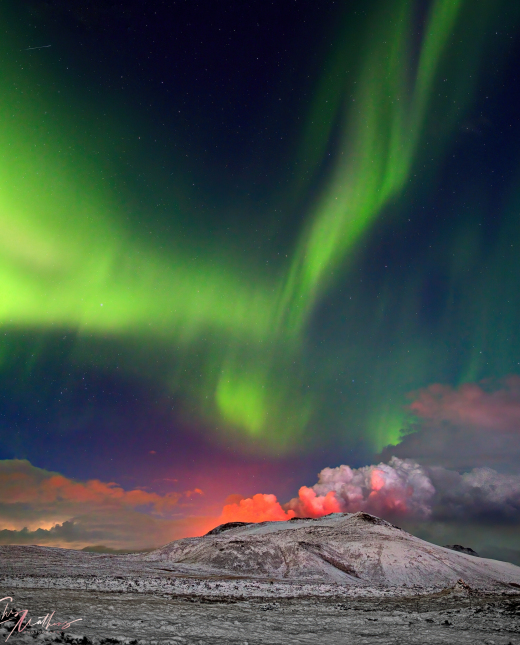It's a bit cold this spring. Lots of heavy clouds in the sky. At https://phys.org/news/2021-03-iceland-volcanic-eruption-hauler.html … the long haul we are told. The volcanic eruption on Iceland's Reykjane Peninsular, 20 mile or so from the captial. Reykjavik, looks like it will continue for a long time. Recently. https://spaceweather.com had a spectacular image of aurorae over the volcano …
 … and it also features in April's Down to Earth geology newletter [2021]. A tranquil green valley has been transformed – and is ttracting sightseers by the bucket full. It is claimed the magma comes directly from the Mantle, 9 miles beneath the surface on Iceland. Unlike most volcanoes, where magma madkes its' way throught the crust, incrementally, or in stages, this one is coming straight up, like a plume. It is, after all, located on the Mid Ocean Ridge. The last time an eruption on the peninsular occurred was back in the 13th century AD, and it went on for 30 years.
… and it also features in April's Down to Earth geology newletter [2021]. A tranquil green valley has been transformed – and is ttracting sightseers by the bucket full. It is claimed the magma comes directly from the Mantle, 9 miles beneath the surface on Iceland. Unlike most volcanoes, where magma madkes its' way throught the crust, incrementally, or in stages, this one is coming straight up, like a plume. It is, after all, located on the Mid Ocean Ridge. The last time an eruption on the peninsular occurred was back in the 13th century AD, and it went on for 30 years.
This one began with a 3 week period of seismic activity and then a fissure developed on Fagradalsfjald, a mountain on the peninsular. The fissure is now 500m in length. Down to Earth has lots of nice images. See also a video at www.mbl.is/frettir/innlet/2021/03/21/horft_ofen_i_angad/ …
At https://phys.org/news/2021-03-weird-earthquake-reveals-hidden-mechanism…. … something not quite right with plate tectonics? Might be. At this link we have an earthqauake in Alaska where there should not have been one, according to mainstream thinking. It occurred in the Shumgin Islands region of Alaska – not that far from a subduction zone. In fact, the subduction zone was the scene of a slightly earlier earthquake, but the anomalous one occurred slap bang in the middle of the Pacific plate. The author of the piece assures us, there must be a hidden fault in the area – but we can't see it.
At www.newscientist.com/2271871-volcanic-eruption-may-have-forced-ancient-e… [see also https://doi.org/10.15184/aqy.2021.16 ]. The city of Bernike on the Red Sea coast was abandoned between 220 and 200BC. It was repopulated shortly afterwards and thrived during the Roman period. Why was it abandoned? The dates fall into a period marked out by Mike Baillie as a prominent low growth tree ring event, centred on 207BC. Is there a connection?
Finally, at https://phys.org/news/2021-03-basalt-beneath-ocean.html … a new type of basalt discovered beneath the ocean, created by volcanic eruptions on the sea bed of the Pacific. A more dramatic and mucl hotter kind of magma was involved, it is intimated. Proof of very powerful volcanoes under the waves.
